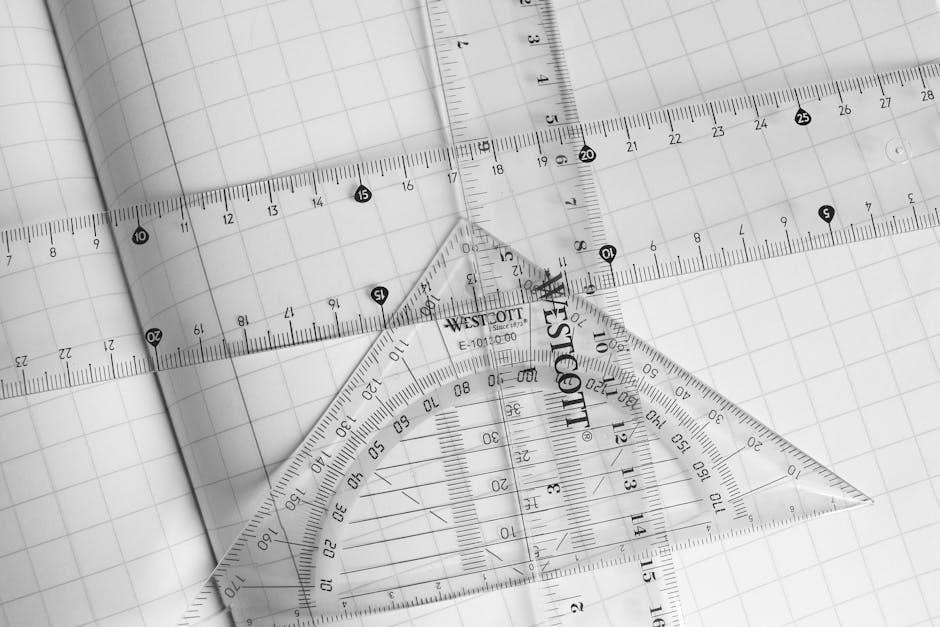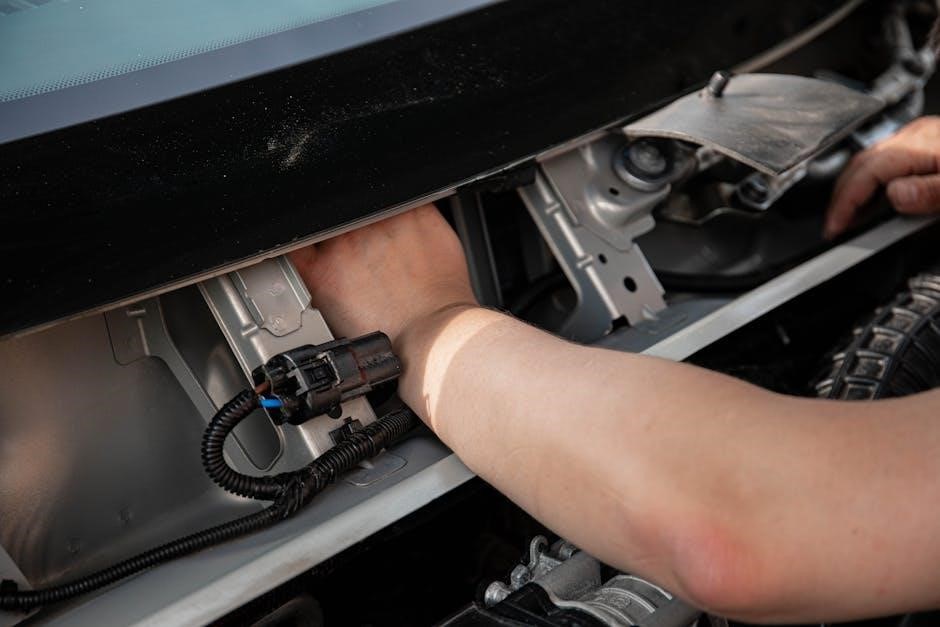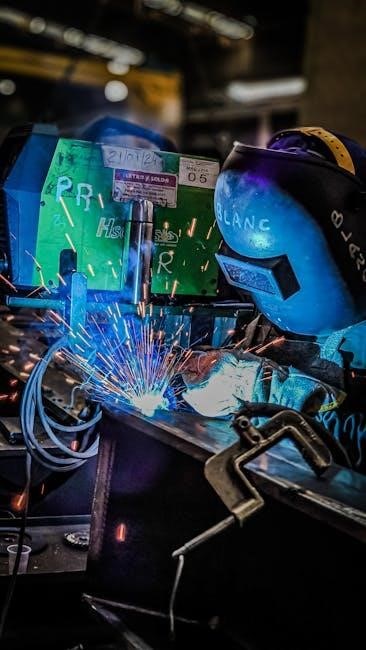Electrical tools are essential for modern work, ensuring efficiency and safety. This guide provides a comprehensive list with names, pictures, and uses, perfect for quick reference.
1.1 Importance of Electrical Tools in Modern Work
Electrical tools are indispensable in modern work, ensuring efficiency, safety, and precision in various tasks. From installations to repairs, these tools empower professionals to handle electrical systems confidently. Their evolution has introduced specialized options, enhancing versatility and reliability. With the right tools, electricians can complete jobs accurately, reducing risks and improving outcomes. Proper tools are vital for meeting industry standards and maintaining workplace safety, making them a cornerstone of electrical trade success.
1.2 Brief Overview of Essential Tools for Electricians
Electricians rely on a variety of essential tools to perform tasks efficiently. These include screwdrivers, pliers, tape measures, electrical tape, wire strippers, and multimeters. Each tool serves a specific purpose, from driving screws to measuring voltage. A well-organized set of tools ensures quick access and enhances productivity. For beginners, a downloadable PDF guide provides names, pictures, and uses of these tools, making it easier to identify and utilize them effectively in electrical work.

Common Electrical Tools and Their Uses
Essential tools include screwdrivers, pliers, tape measures, electrical tape, wire strippers, and multimeters. These tools are crucial for tasks like driving screws, measuring voltage, and stripping wires efficiently.
2.1 Screwdrivers (Flat, Phillips, and Allen)
Screwdrivers are fundamental tools for electricians, available in flat, Phillips, and Allen types. Flat screwdrivers handle slotted screws, while Phillips drivers manage cross-head screws. Allen wrench screwdrivers are used for hexagonal sockets. Each type ensures precise control, reducing cam-out risks. Insulated handles enhance safety, protecting against electrical shock. These tools are indispensable for various electrical tasks, from circuit breakers to terminal connections, making them a must-have in every electrician’s kit.
2.2 Pliers (Needle-Nose, Slip-Joint, and Insulated)
Needle-nose pliers excel at reaching tight spaces for precise gripping. Slip-joint pliers are versatile, ideal for gripping objects of various sizes. Insulated pliers ensure safety while working with live circuits, preventing electrical shock. These tools are crucial for wire bending, gripping small components, and ensuring secure connections. Each type of plier is tailored for specific tasks, making them indispensable in an electrician’s toolkit for efficient and safe electrical work.
2.3 Tape Measure
A tape measure is a versatile tool essential for precise measurements in electrical work. It allows electricians to accurately measure wires, spaces, and materials. Durable and portable, tape measures often feature both inch and centimeter markings, ensuring adaptability for various projects. They are crucial for cutting materials to the correct length and ensuring proper fitment, making them a fundamental component of every electrician’s toolkit for efficient and accurate electrical installations.
2.4 Electrical Tape
Electrical tape is a must-have for insulating wires and protecting electrical connections. It offers a durable, water-resistant barrier against current leakage and environmental factors. Available in various colors, it helps in color-coding wires for easy identification. Its flexibility allows it to conform to irregular surfaces, ensuring secure and reliable insulation. Regularly used for temporary fixes or permanent installations, electrical tape is an indispensable tool for maintaining safety and efficiency in electrical work.
2.5 Wire Strippers and Crimpers
Wire strippers and crimpers are essential for preparing and connecting wires. Strippers safely remove insulation without damaging the conductor, while crimpers secure connectors and terminals. Available in manual or automatic designs, they ensure precise, efficient work. Regular maintenance, like cleaning and replacing blades, is crucial for optimal performance. These tools are vital for creating reliable electrical connections, making them indispensable in any electrician’s toolkit.
Measuring and Testing Tools
Essential for diagnosing electrical systems, these tools include multimeters, insulation testers, and circuit testers. They ensure accurate measurements and safe troubleshooting in various electrical scenarios.
3.1 Multimeter (Voltage, Current, Resistance)
A multimeter is a versatile tool measuring voltage, current, and resistance. It helps diagnose electrical issues, ensuring circuits operate safely and efficiently. Digital models offer precise readings, while analog versions provide real-time feedback. Regular calibration is essential for accuracy. This device is indispensable for professionals and DIYers, enabling quick troubleshooting and preventing potential hazards. Understanding its use is crucial for effective electrical work and safety.
3.2 Insulation Tester
An insulation tester measures resistance in electrical insulation, ensuring safety and preventing hazards. It verifies the integrity of wiring and components, detecting faults or degradation. Modern testers often include voltage detection for added convenience. Regular use helps maintain electrical systems, preventing potential failures. This tool is vital for ensuring compliance with safety standards and prolonging equipment lifespan; Proper use requires understanding of test procedures and interpretation of results for accurate assessments.
3.3 Circuit Tester
A circuit tester identifies live wires, ensuring safe electrical work. It detects voltage presence without direct contact, preventing shocks. LED lights or sounds indicate live circuits. This tool is essential for diagnosing issues, verifying repairs, and ensuring de-energized systems. Regular use enhances safety protocols, protecting both technicians and equipment. Proper handling and interpretation of results are crucial for accurate testing and effective troubleshooting in various electrical environments.

Safety and Insulated Tools
Safety and insulated tools are crucial for protecting electricians. Insulated screwdrivers, pliers, and tool belts prevent accidents, ensuring safe handling and organized workspaces.
4.1 Insulated Screwdrivers and Pliers
Insulated screwdrivers and pliers are vital for electrical work. Made from high-quality tool steel, they ensure safety near live circuits. Screwdrivers come in flat, Phillips, and Allen types, while pliers include needle-nose, slip-joint, and insulated versions. These tools prevent electrical shocks and are designed for durability. Regular inspection and maintenance are essential to uphold their protective features and ensure reliable performance during tasks.
4.2 Electrician Tool Belt and Storage Solutions
A well-organized electrician tool belt is essential for efficiency and safety. It typically features multiple pockets for small parts and hand tools, with dedicated spaces for electrical tools. Storage solutions like toolboxes, portable cases, and wall-mounted systems help keep tools tidy and accessible. Proper organization reduces clutter, enhances workplace safety, and ensures tools are within easy reach, making electrical tasks more manageable and professional.

Power Tools for Electrical Work
Power tools like drills, impact drivers, and soldering irons are essential for electrical tasks. They offer versatility, efficiency, and precision, ensuring safe and professional electrical work execution.
5.1 Drills and Impact Drivers
Drills and impact drivers are versatile power tools used in electrical work for drilling holes and driving screws. They are designed for precision and durability, ensuring efficient task completion. These tools are essential for installing electrical components, such as outlets and switches, and are often used with various drill bits and driver attachments to suit different tasks. Proper maintenance ensures optimal performance and longevity in electrical projects.
5.2 Soldering Iron and Soldering Station
A soldering iron and soldering station are essential for connecting electrical components securely. The iron heats solder, creating a conductive bond between wires or circuit boards. Soldering stations offer precise temperature control, improving safety and efficiency. These tools are crucial for electrical work, ensuring durable connections. They are often included in professional-grade toolkits and are indispensable for tasks requiring precision and reliability in electrical projects.

Fastening and Cutting Tools
Essential for shaping and securing materials, these tools include hammers, chisels, bolt cutters, and tin snips. They enable precise cutting and fastening in electrical projects.
6.1 Hammers and Chisels
Hammers and chisels are fundamental tools in electrical work, essential for breaking apart materials and fitting components. Common types include claw hammers for pulling nails and ball-peen hammers for shaping metal. Chisels are used for cutting and removing material. Both tools are vital for demolition, prying, and adjusting electrical components, ensuring precise and safe installations.
6.2 Bolt Cutters and Tin Snips
Bolt cutters and tin snips are essential tools for cutting tasks in electrical work. Bolt cutters are used to cut chains, wires, and bolts, while tin snips are ideal for cutting metal sheets or strips. Aviation-type tin snips with yellow handles are commonly recommended. These tools feature heavy-duty frames and comfortable grips, ensuring efficiency and safety for various electrical applications. They are indispensable for precise cutting in both residential and industrial settings.

Safety Precautions and Best Practices
Keep work areas clean and well-lit to prevent accidents. Avoid using power tools near flammable substances or in explosive environments. Regularly inspect tools for damage to ensure safe operation.
7.1 Work Area Safety Tips
Maintain a clean and well-lit workspace to minimize risks. Avoid clutter and ensure proper ventilation. Keep flammable materials away from power tools. Use non-conductive tools near live circuits. Store tools securely to prevent accidental falls. Ensure all electrical equipment is properly grounded. Never work in explosive environments or near hazardous materials without proper safety gear. Regularly inspect cords and tools for damage. Always turn off power sources before starting work. Keep emergency tools, like fire extinguishers, nearby for quick access. Refer to the PDF guide for detailed safety protocols.
7.2 Proper Tool Maintenance and Inspection
Regularly inspect and maintain tools to ensure optimal performance and safety. Clean and lubricate moving parts to prevent rust and wear. Store tools in a dry, secure location to avoid damage. Inspect cords and cables for frays or damage before use. Test insulated tools periodically to ensure they remain safe for live circuits. Replace worn or damaged components promptly. Proper maintenance extends tool life and prevents workplace accidents. Always follow manufacturer guidelines for servicing and upkeep.

Guide to Choosing the Right Tools
Select tools based on job requirements, durability, and safety features. Consider budget-friendly options for beginners and professional-grade tools for experienced electricians to ensure efficiency and reliability.
8.1 Budget-Friendly Options for Beginners
For beginners, selecting affordable tools is crucial without compromising quality. Basic tools like screwdrivers, pliers, and tape measures are essential. Look for starter kits or non-branded options that meet safety standards. These tools provide a cost-effective way to build a foundational toolkit, ensuring you can perform common tasks efficiently while staying within budget.
8.2 Professional-Grade Tools for Experts
Professional-grade tools are designed for durability and precision, catering to experienced electricians. High-quality multimeters, insulated screwdrivers, and specialized wire strippers ensure reliability in complex tasks. These tools often feature advanced materials and ergonomic designs, enhancing efficiency and safety. Investing in professional-grade equipment is essential for experts requiring consistent performance and longevity in demanding electrical work environments.

Classification of Electrical Tools
Electrical tools are classified into driving tools like screwdrivers and hammers, and cutting tools such as pliers and shears, each serving specific purposes in electrical tasks.
9.1 Driving Tools (Screwdrivers, Hammers)
Driving tools, such as screwdrivers and hammers, are essential for electrical work. Screwdrivers (Philips, flat, and Allen) are used for driving screws, while hammers are utilized for fitting parts and light demolition. These tools are categorized based on their functionality, ensuring precision and efficiency in various electrical tasks. Refer to the PDF guide for detailed names, pictures, and descriptions of these fundamental driving tools.
9.2 Cutting Tools (Wrenches, Shears)
Cutting tools, such as wrenches and shears, are vital for electrical tasks requiring precision and strength. Wrenches are used for gripping and twisting objects, while shears are designed for cutting wires and cables. Insulated wrenches and shears are made from high-quality tool steel, ensuring durability and safety. Examples include bolt cutters and tin snips, essential for various electrical projects. Refer to the PDF guide for detailed names, pictures, and descriptions of these cutting tools.

Storage and Organization Solutions
Proper storage enhances efficiency and safety. Use toolboxes, portable cases, or wall-mounted systems to keep tools organized and accessible, ensuring your workspace remains clutter-free and productive.
10.1 Toolboxes and Portable Cases
Toolboxes and portable cases are essential for organizing electrical tools. They provide secure storage, protecting tools from damage and keeping them easily accessible. Portable cases are ideal for electricians on the go, offering durability and customization options to fit specific needs. Many-feature multiple compartments and padded interiors, ensuring tools remain tidy and within reach. Investing in a high-quality toolbox or case enhances workflow efficiency and prolongs tool lifespan.
10.2 Wall-Mounted Storage Systems
Wall-mounted storage systems are ideal for maximizing space and keeping tools organized. They feature adjustable hooks, bins, and trays, ensuring easy access to frequently used items. Durable materials like steel ensure long-lasting performance. These systems are perfect for workshops or garages, complementing portable toolboxes. By keeping tools visible and within reach, wall-mounted solutions enhance efficiency and reduce clutter, making them a practical addition to any electrical workspace.

Downloadable PDF Guide
A comprehensive PDF guide provides detailed lists, images, and descriptions of essential electrical tools. Perfect for quick reference, it helps professionals and beginners identify and understand tool applications.
11.1 Features of the Comprehensive Guide
The PDF guide offers detailed listings of electrical tools, including names, high-quality images, and descriptions. It covers essential tools for professionals and beginners, ensuring clarity and ease of reference. Organized neatly, the guide includes sections on screwdrivers, pliers, multimeters, and more, making it a valuable resource for understanding and identifying tools efficiently.
11.2 How to Use the PDF for Quick Reference
The PDF guide is designed for easy navigation, featuring tool names, images, and descriptions. Users can quickly locate specific tools by browsing categorized sections, such as screwdrivers or pliers. The guide also includes visual aids for identification, making it ideal for both beginners and professionals. Perfect for on-the-go reference, it ensures efficient tool selection and understanding, enhancing productivity in electrical work environments.
Electrical tools are vital for safe and efficient work. This guide provides essential names, pictures, and uses, serving as a valuable resource for mastering electrical tasks effectively.
12.1 Recap of Essential Tools
Essential electrical tools include screwdrivers, pliers, tape measures, and electrical tape. Multimeters and insulated tools ensure safety and precision. A downloadable PDF guide provides names, pictures, and uses for quick reference, helping professionals master electrical tasks efficiently and safely;
12.2 Final Tips for Mastering Electrical Work
Mastering electrical work requires a combination of skill, safety, and organization. Always maintain clean, well-lit workspaces and inspect tools regularly. Stay updated with industry advancements and practice proper techniques. Invest in a comprehensive PDF guide for quick reference. Continuously learn from mistakes and adapt to new tools and technologies to ensure efficiency and precision in every task.
